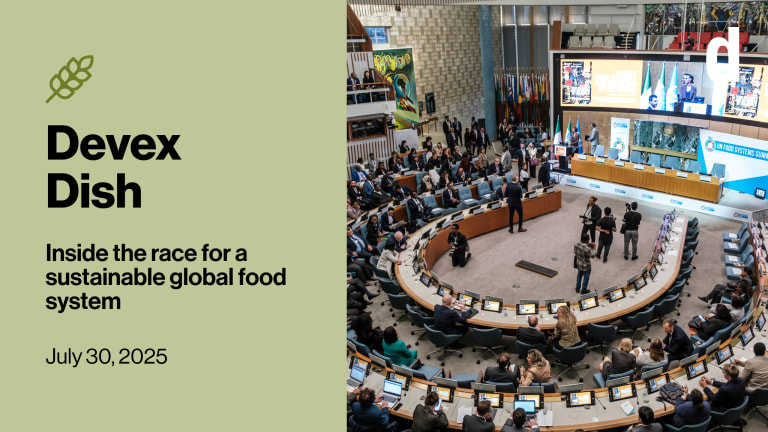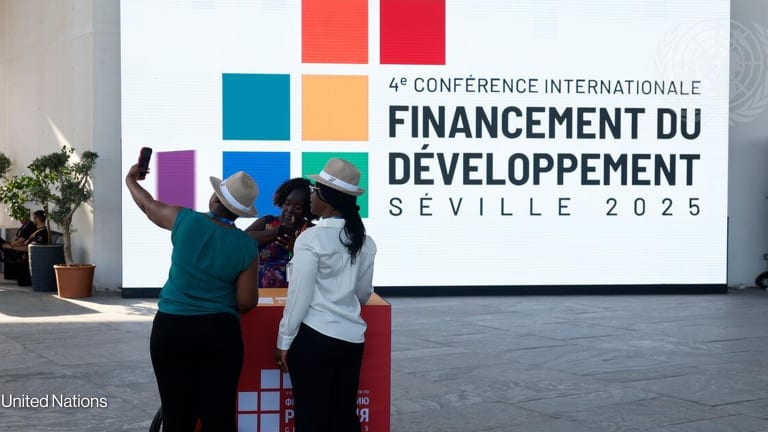
EDITOR’S NOTE: In the next 25 years, people who are constantly at risk of falling into poverty will comprise the bulk of India’s population. What will this mean for the development community? Center for Global Development President Nancy Birdsall asks in this article for the Global Development: Views from the Center blog.
I was in Delhi recently for the launch of CGD’s India Initiative. Along with CGD colleagues Lant Pritchett and Arvind Subramanian, I participated in a session hosted by Pratap Mehta of the Centre for Policy Research and moderated by Minister Jairam Ramesh (Minister of Rural Development, former Minister of Energy and Environment). Arvind blogged about the event last week.
Here is the slide deck I presented. I tried to suggest a very India-specific development challenge: Can the world’s largest low-income democracy build a capable, responsive, inclusive and sustainable state, long before it has the secure middle class which many students of history believe has been the bedrock and ballast of mature democracies? (Colleagues including Pratap Mehta at CPR and Patrick Heller of Brown University now in residence at CPR are working on the role of the middle class in India.)
And what does that challenge in India say about the key challenge for the international development community in the next decade?
First: Why this question? Doesn’t India already have a big middle class? Yes in absolute terms (we estimate 70 million). But in relative terms, in a country of over 1 billion people, no.
In India, it is a different “class” of people that is expanding – in an extreme case of what could be a phenomenon in other low-income countries enjoying 21st century growth of 3 to 6 percent or more. That is a class that lives above the poverty line, but well below the level associated historically with the secure middle class in now-developed countries.
Call them the 4-10s, that is people living in households in which income per capita is between $4 and $10 a day, at 2005 PPP dollars. They are not poor by the standard in India (for rural areas around $1.25 per capita per day) but they are still at constant risk of falling into poverty – whether due to a health problem, a natural disaster or an economic downturn. (With colleagues I am studying the relationship of the 4-10s to the state in Latin America: Are they beneficiaries of publicly provided goods and services, or victims of police harassment and poor access to justice? Are they “givers”, as taxpayers, or “getters”, as recipients of cash transfers, fuel and other subsidies?)
In India, the 4-10s are today about 12 percent of the population – escapees from poverty thanks to the rapid growth of the last couple of decades in India; by 2030, less than 20 years from now, using a conservative baseline growth estimate, they will be 44 percent of the population – about 650 million people. With a hat tip to this chart on the rise of Latin America’s middle class from The Economist, our chart below illustrates that for at least the next 25 years it is 4-10s that will occupy center stage in India – not the richer “middle” class.
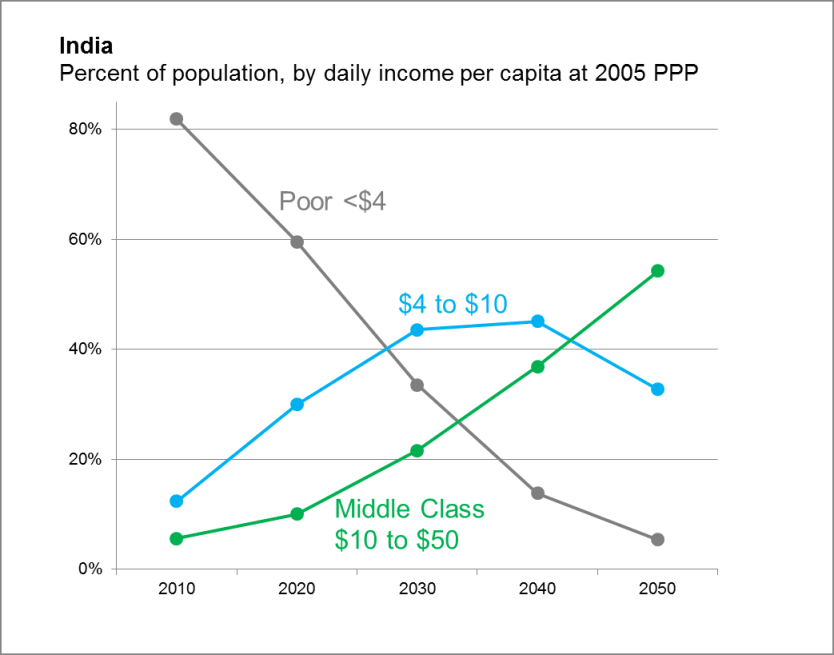
From some points of view, for IKEA and Dunkin Donuts, the 4-10s represent new global consumers – and as consumers they are bound to contribute to a more dynamic and more productive market – and thus to economic growth. But as voters and citizens, will they play the “middle class” role which to which Aristotle referred -
It is manifest that the best political community is formed by citizens of the middle class, and that those states are likely to be well administered in which the middle class is large, and stronger if possible than both the other classes, or at any rate than either singly; for the addition of the middle class turns the scale, and prevents either of the extremes from being dominant.
- Aristotle Politics, Book IV, p. 1296
and which directly or indirectly, students of economic development have invoked as the ballast of inclusive economics and sustainable democratic politics (Engerman and Sokoloff, 1997; Easterly 2001; Acemoglu and Robinson, 2012)?
It is not obvious that they will. At $4-$10 a day, in today’s global economy, life is still Hobbesian: nasty, brutish and often short – as in for example The White Tiger.
In contrast, being middle class in a global economy means, for sociologists, being reasonably secure from falling into poverty. Economists are beginning to converge on a minimum income of $10 per person per day as a good proxy for being reasonably secure and thus middle class in the classic sense across the developing world. Research at the World Bank has shown that in several countries of Latin America, the likelihood of a household falling back into poverty ($4 or less) starts to decline rapidly – to 10 percent or less a day – when household income per capita reaches $10. At that income level adults have on average completed secondary schooling.
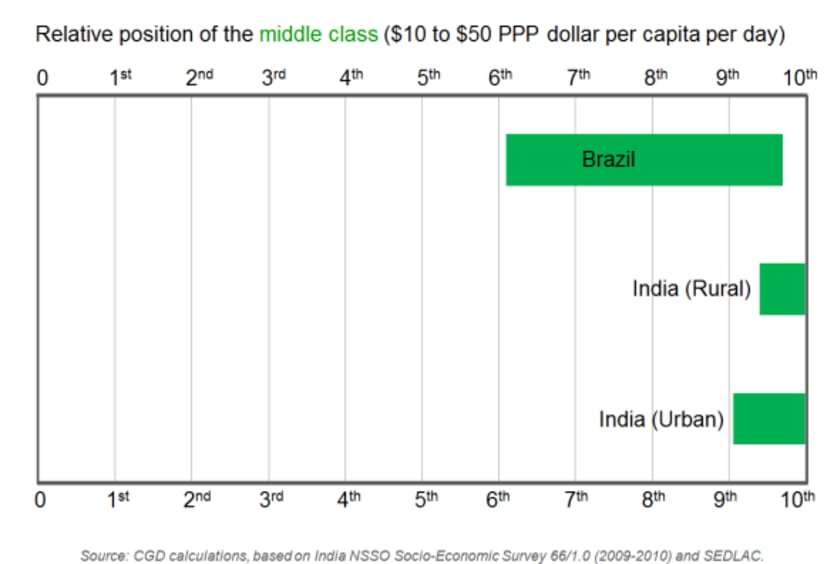
In Brazil and China, the next three decades is about growth of the 10-50 middle class; in India using our projections of growth (and assuming no change in the current distribution of income), the middle class will still be small in 30 years. In India, the next three decades are instead about growth of the 4-10s – the vulnerable and perhaps the “catalytic” politically.
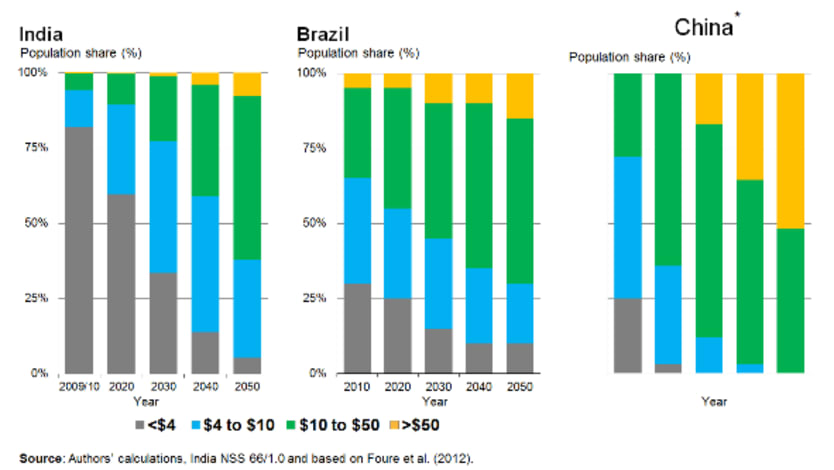
Who are these 4-10s? We know that in India adults in 4-10 households have completed about seven years of school – the same more or less as adults in 4-10 households in Brazil.
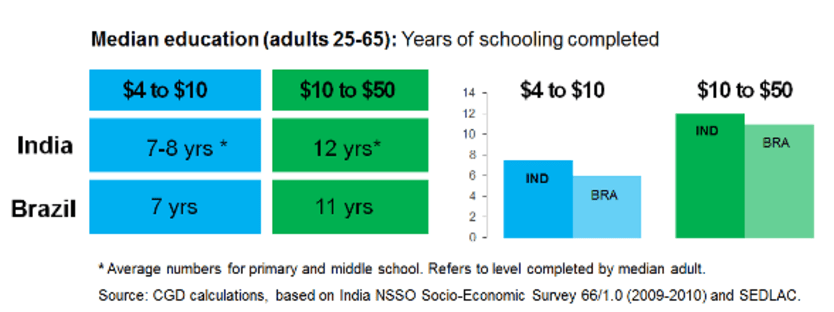
And we know that for the most part they work in the low-productivity, low-return informal sector(consider Mohamed Bouazzizi, the Tunisian fruit vendor whose self-immolation catalyzed the Arab Spring), in which they are untaxed but unprotected and with poor access to capital (Banerjee and Duflo, 2007).
It is growth that has fueled the increase in the 4-10s – in a good sense, as people escape poverty. But can the growth of the recent past be sustained? Will it generate more productive jobs for India’s 4-10s?
Perhaps there is a deeper challenge in India: to build what Lant Pritchett refers to as “organizational capability” and Devesh Kapur as “state capability” — that is accountable to its large and growing vulnerable class, before it has the large and secure $10 and above-style) middle class on which most existing democracies were (back to Aristotle and recent scholars) built? In other words, can India’s 4-10s be the contributors and beneficiaries of a social contract that works in the world’s largest low-income democracy?
What does that imply for the development community accustomed to focusing more on reducing poverty than on building democratic institutions?
Republished with permission from the Center for Global Development. Read the original article.







